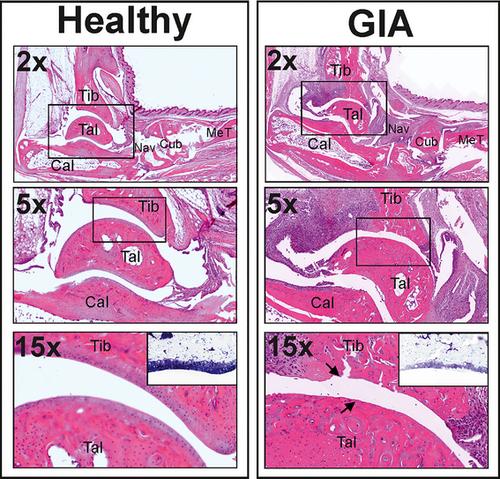{"title":"重组人蛋白多糖 Aggrecan-G1 域诱导的关节炎(GIA)小鼠模型。","authors":"Katalin Olasz, Ferenc Boldizsar","doi":"10.1002/cpz1.1053","DOIUrl":null,"url":null,"abstract":"<p>The recombinant human proteoglycan aggrecan-G1 domain (rhG1)-induced arthritis (GIA) mouse model is a complex model of rheumatoid arthritis (RA). In GIA, autoimmune arthritis is induced by repeated intraperitoneal immunization of genetically susceptible BALB/c mice with the rhG1 antigen emulsified in the adjuvant dimethyldioctadecylammonium (DDA). This article describes the steps for producing and purifying the rhG1 antigen, the immunization protocol, methods for following the clinical picture of arthritis, and the evaluation of relevant laboratory parameters. In this model, the autoimmune arthritis develops stepwise, similar to RA: First is the preclinical stage (after the first immunization, days 0-20) with no sign of inflammation but detectable T and B cell activation; next, the stage of early arthritis (after the second immunization, days 21-41), where the first definitive signs of arthritis appear together with autoantibody production; and then the severe late-stage arthritis (after the third immunization, after day 42), which presents with massive inflammation of the limbs, leading to cartilage and bone destruction and finally ankylosis. The protocols described here provide sufficient information for investigators to use the GIA model to study different aspects of autoimmune arthritis. © 2024 The Authors. Current Protocols published by Wiley Periodicals LLC.</p><p><b>Basic Protocol</b>: Induction of recombinant human proteoglycan aggrecan-G1 domain (rhG1)-induced arthritis (GIA)</p><p><b>Support Protocol 1</b>: Production of rhG1-Xa-mFc2a fusion protein with CHOK1 mammalian expression system</p><p><b>Support Protocol 2</b>: Purification of the rhG1-Xa-mFc2a fusion protein by affinity chromatography</p><p><b>Support Protocol 3</b>: Preparation of DDA adjuvant</p><p><b>Support Protocol 4</b>: Clinical assessment of arthritis</p><p><b>Support Protocol 5</b>: Measurement of serum antibody levels and cytokines</p><p><b>Support Protocol 6</b>: Measurement of rhG1-induced proliferation and cytokine production in spleen cell culture</p><p><b>Support Protocol 7</b>: Histological assessment of arthritic limbs</p><p><b>Support Protocol 8</b>: Evaluation of arthritis with micro-computed tomography</p>","PeriodicalId":93970,"journal":{"name":"Current protocols","volume":null,"pages":null},"PeriodicalIF":0.0000,"publicationDate":"2024-05-16","publicationTypes":"Journal Article","fieldsOfStudy":null,"isOpenAccess":false,"openAccessPdf":"https://onlinelibrary.wiley.com/doi/epdf/10.1002/cpz1.1053","citationCount":"0","resultStr":"{\"title\":\"Recombinant Human Proteoglycan Aggrecan-G1 Domain-induced Arthritis (GIA) Mouse Model\",\"authors\":\"Katalin Olasz, Ferenc Boldizsar\",\"doi\":\"10.1002/cpz1.1053\",\"DOIUrl\":null,\"url\":null,\"abstract\":\"<p>The recombinant human proteoglycan aggrecan-G1 domain (rhG1)-induced arthritis (GIA) mouse model is a complex model of rheumatoid arthritis (RA). In GIA, autoimmune arthritis is induced by repeated intraperitoneal immunization of genetically susceptible BALB/c mice with the rhG1 antigen emulsified in the adjuvant dimethyldioctadecylammonium (DDA). This article describes the steps for producing and purifying the rhG1 antigen, the immunization protocol, methods for following the clinical picture of arthritis, and the evaluation of relevant laboratory parameters. In this model, the autoimmune arthritis develops stepwise, similar to RA: First is the preclinical stage (after the first immunization, days 0-20) with no sign of inflammation but detectable T and B cell activation; next, the stage of early arthritis (after the second immunization, days 21-41), where the first definitive signs of arthritis appear together with autoantibody production; and then the severe late-stage arthritis (after the third immunization, after day 42), which presents with massive inflammation of the limbs, leading to cartilage and bone destruction and finally ankylosis. The protocols described here provide sufficient information for investigators to use the GIA model to study different aspects of autoimmune arthritis. © 2024 The Authors. Current Protocols published by Wiley Periodicals LLC.</p><p><b>Basic Protocol</b>: Induction of recombinant human proteoglycan aggrecan-G1 domain (rhG1)-induced arthritis (GIA)</p><p><b>Support Protocol 1</b>: Production of rhG1-Xa-mFc2a fusion protein with CHOK1 mammalian expression system</p><p><b>Support Protocol 2</b>: Purification of the rhG1-Xa-mFc2a fusion protein by affinity chromatography</p><p><b>Support Protocol 3</b>: Preparation of DDA adjuvant</p><p><b>Support Protocol 4</b>: Clinical assessment of arthritis</p><p><b>Support Protocol 5</b>: Measurement of serum antibody levels and cytokines</p><p><b>Support Protocol 6</b>: Measurement of rhG1-induced proliferation and cytokine production in spleen cell culture</p><p><b>Support Protocol 7</b>: Histological assessment of arthritic limbs</p><p><b>Support Protocol 8</b>: Evaluation of arthritis with micro-computed tomography</p>\",\"PeriodicalId\":93970,\"journal\":{\"name\":\"Current protocols\",\"volume\":null,\"pages\":null},\"PeriodicalIF\":0.0000,\"publicationDate\":\"2024-05-16\",\"publicationTypes\":\"Journal Article\",\"fieldsOfStudy\":null,\"isOpenAccess\":false,\"openAccessPdf\":\"https://onlinelibrary.wiley.com/doi/epdf/10.1002/cpz1.1053\",\"citationCount\":\"0\",\"resultStr\":null,\"platform\":\"Semanticscholar\",\"paperid\":null,\"PeriodicalName\":\"Current protocols\",\"FirstCategoryId\":\"1085\",\"ListUrlMain\":\"https://onlinelibrary.wiley.com/doi/10.1002/cpz1.1053\",\"RegionNum\":0,\"RegionCategory\":null,\"ArticlePicture\":[],\"TitleCN\":null,\"AbstractTextCN\":null,\"PMCID\":null,\"EPubDate\":\"\",\"PubModel\":\"\",\"JCR\":\"\",\"JCRName\":\"\",\"Score\":null,\"Total\":0}","platform":"Semanticscholar","paperid":null,"PeriodicalName":"Current protocols","FirstCategoryId":"1085","ListUrlMain":"https://onlinelibrary.wiley.com/doi/10.1002/cpz1.1053","RegionNum":0,"RegionCategory":null,"ArticlePicture":[],"TitleCN":null,"AbstractTextCN":null,"PMCID":null,"EPubDate":"","PubModel":"","JCR":"","JCRName":"","Score":null,"Total":0}
引用次数: 0
Recombinant Human Proteoglycan Aggrecan-G1 Domain-induced Arthritis (GIA) Mouse Model
The recombinant human proteoglycan aggrecan-G1 domain (rhG1)-induced arthritis (GIA) mouse model is a complex model of rheumatoid arthritis (RA). In GIA, autoimmune arthritis is induced by repeated intraperitoneal immunization of genetically susceptible BALB/c mice with the rhG1 antigen emulsified in the adjuvant dimethyldioctadecylammonium (DDA). This article describes the steps for producing and purifying the rhG1 antigen, the immunization protocol, methods for following the clinical picture of arthritis, and the evaluation of relevant laboratory parameters. In this model, the autoimmune arthritis develops stepwise, similar to RA: First is the preclinical stage (after the first immunization, days 0-20) with no sign of inflammation but detectable T and B cell activation; next, the stage of early arthritis (after the second immunization, days 21-41), where the first definitive signs of arthritis appear together with autoantibody production; and then the severe late-stage arthritis (after the third immunization, after day 42), which presents with massive inflammation of the limbs, leading to cartilage and bone destruction and finally ankylosis. The protocols described here provide sufficient information for investigators to use the GIA model to study different aspects of autoimmune arthritis. © 2024 The Authors. Current Protocols published by Wiley Periodicals LLC.
Basic Protocol: Induction of recombinant human proteoglycan aggrecan-G1 domain (rhG1)-induced arthritis (GIA)
Support Protocol 1: Production of rhG1-Xa-mFc2a fusion protein with CHOK1 mammalian expression system
Support Protocol 2: Purification of the rhG1-Xa-mFc2a fusion protein by affinity chromatography
Support Protocol 3: Preparation of DDA adjuvant
Support Protocol 4: Clinical assessment of arthritis
Support Protocol 5: Measurement of serum antibody levels and cytokines
Support Protocol 6: Measurement of rhG1-induced proliferation and cytokine production in spleen cell culture
Support Protocol 7: Histological assessment of arthritic limbs
Support Protocol 8: Evaluation of arthritis with micro-computed tomography


 求助内容:
求助内容: 应助结果提醒方式:
应助结果提醒方式:


